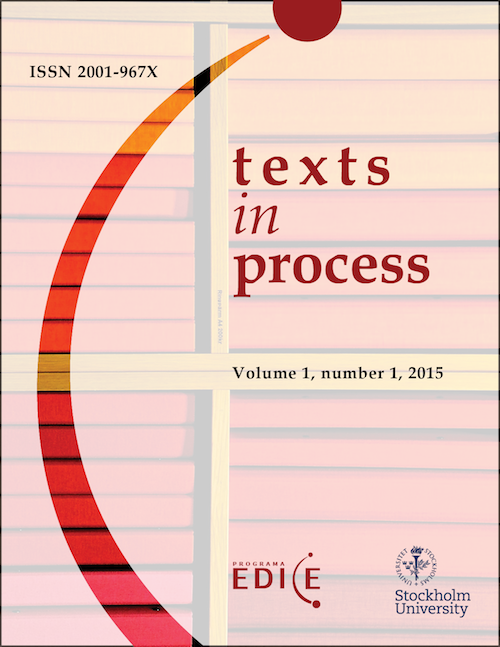Metacommunication in the judiciary field: formulations
A proposal for cataloging and an approach to facework in institutional contexts
Abstract
This work is in the line of Conversation Analysis concerning institutional types of asymmetrical situations (Drew & Heritage, 1992; Orletti, 2000) and, particularly, judicial oral interactions (Mariottini, 2013a, 2013b). The aim is to investigate the uses and the interactional and social functions of the metacommunicative practices here occurring. Data proceed from COrAL – Corpus Oral de Ámbito Legal (Oral Corpus of Legal Context; Mariottini, forthcoming), composed by transcriptions of (video)recordings of oral trials, whose current extension is 22 hours and 53 minutes. The result of the qualitative analysis carried out for this article is to identify different types of formulations and to propose a classification according to interactional and social functions played by each type.
Downloads
References
Atkinson, J. M. y Drew, P. (1979). Order in court. Atlantic Highlands: Oxford Socio-Legal Studies.
Boden, D. y Zimmerman, D.H. (Eds.) (1991). Talk and Social Structure: Studies in Ethnomethodology and Conversation Analysis. Cambridge: Polity Press.
Bolden, B. G. (2010). ‘Articulating the unsaid’ via and-prefaced formulations of others’ talk. Discourse Studies, 12(1), pp. 5-32. http://dx.doi.org/10.1177/1461445609346770
Bravo, D. (2002). Actos asertivos y cortesía: Imagen del rol en el discurso de académicos argentinos. En Placencia, M. E. y Bravo, D. (Eds.) Actos de habla y cortesía en español (pp. 141-174). München: LINCOM.
Bravo, D. (2005). Categorías, tipologías y aplicaciones: Hacia una redefinición de la cortesía comunicativa. En Bravo D. (Ed.) Estudios de la (des)cortesía en español. Categorías conceptuales y aplicaciones a corpora orales y escritos (pp. 21-52). Buenos Aires: Dunken.
Briz, A. y Grupo Val.Es.Co. (2002). Corpus de conversaciones coloquiales. Madrid: Arco/Libros.
Coulthard, M. (2010). A Handbook of Forensic Linguistics. London: Routledge.
Coulthard, M. y Johnson, A. (Eds.) (2007). An Introduction to Forensic Linguistics: Language in Evidence. London: Routledge.
Culpeper, J. (1996). Towards an anatomy of impoliteness. Journal of Pragmatics, 25, pp. 349-367. http://dx.doi.org/10.1007/s10746-011-9187-8
Deppermann, A. (2011). The Study of Formulations as a Key to an Interactional Semantics. Hum Stud, 34, 115-128. http://dx.doi.org/10.1007/s10746-011-9187-8
Drew, P. (2003). Comparative Analysis of Talk-in-Interaction in Different Institutional Settings: A Sketch. En Glenn, P. J., LeBaron, C. D. y Mandelbaum, J. (Eds.), Studies in Language and Social Interaction: In Honor of Robert Hopper (pp. 293-308). London: Erlbaum.
Drew, P. y Heritage, J. (1992). Talk at work: Social Interaction in Institutional Settings. Cambridge: Cambridge University Press.
Fele, G. (2009). Glosse e formulazioni. En Fatigante M., Mariottini L. y Sciubba M. E. (Eds.). Lingua e società. Scritti in onore di Franca Orletti (pp. 49-59). Roma: FrancoAngeli.
Franceschini, R. (1994). La metacomunicazione: forme e funzioni nel discorso. Basilea: Acta Romanica Basiliensia 6.
Garfinkel, H. y Sacks, H. (1970). On formal structures of practical actions. En McKinney C. y Tiryakian E. A. (Eds.) Theoretical Sociology (pp. 338-366). New York: Appleton Crofts.
Goodwin, C. (2003). Il senso del vedere. Roma: Meltemi.
Heritage, J. (2013). Language and Social Institutions: The Conversation Analytic View. Journal of Foreign Languages, 36(4), 2-27.
Heritage, J. y Watson, R. (1979). Formulations as conversational objects. En Psathas G. (Ed.), Everyday Language: Studies in Ethnomethodology (pp. 123-162). New York: Irvington.
Kasper, G. (1990). Linguistic Politeness: Current Research Issues. Journal of Pragmatics, 14, 193-218. http://dx.doi.org/10.1016/0378-2166(90)90080-W
Mariottini, L. (2007). La cortesia. Roma: Carocci.
Mariottini, L. (2008). Cibercortesía: estrategias de toma del turno en los chats. En Briz A., Hidalgo A., Albelda M., Contreras J. y Hernández-Flores, N. (Eds.) Cortesía y conversación: de lo escrito a lo oral (pp. 489-502), Valencia/Estocolmo: Universidad de Valencia, Programa EDICE.
Mariottini, L. (2011). El diálogo interaccional. El español actual, 95, pp. 49-65.
Mariottini, L. (2013a). El enfoque conversacional para el estudio de la comunicación forense. El posicionamiento. En Chierichetti L. y Garofalo G. (Eds.) Discurso profesional y lingüística de corpus. Perspectivas de investigación (pp. 139-162). Bergamo: CERLIS Series 3.
Mariottini, L. (2013b). La comunicación forense. La expresión de la agentividad en los juicios orales y sus consecuencias interaccionales e institucionales. Cuadernos AISPI, 2, pp. 99-114.
Mariottini, L. (en prepararción), CORAL - Corpus Oral de Ámbito Legal.
Müller, A. (2006). La cortesía conversacional: análisis secuenciales. En Schrader-Kniffki, M. (Ed.) La cortesía en el mundo hispánico (pp. 157-182). Madrid/Frankfurt am Main: Iberoamericana/Vervuert.
Orletti, F. (1983). Pratiche di glossa. En Orletti, F. (Ed.), Comunicare nella vita quotidiana (pp. 77-103). Bologna: il Mulino.
Orletti, F. (2000). La conversazione diseguale. Roma: Carocci.
Orletti, F. (2009). La comunicazione forense tra interazione verbale e cognizione: la categoria ‘responsabilità’ e i suoi correlati linguistici e interazionali. En Diadori, P. (Ed.) Progetto JURA: la formazione dei docenti di lingua e traduzione in ambito giuridico italo-tedesco (pp. 22-30). Perugia: Guerra.
Orletti, F. (Ed.) (1994). Fra conversazione e discorso. Roma: Carocci.
Persson, R. (2013). Intonation and Sequential organization: Formulations in French talk-in-interaction. Journal of Pragmatics, 57, pp. 19-30. http://dx.doi.org/10.1016/j.pragma.2013.07.004
Pezzotti, M. (2003). La competenza metapragmatica nella produzione dei non nativi: il caso della meta comunicazione. Linguistica e Filologia, 17, pp. 127-182.
Sacks, H., Schegloff, E. y Jefferson, G. (1974). A simplest systematic for the organisation of turn taking for conversation. Language, 50, pp. 696-735. http://dx.doi.org/10.1353/lan.1974.0010
Van der Houwen, F. (2009). Formulating disputes. Journal of Pragmatics, 41, pp. 2072-2085. http://dx.doi.org/10.1016/j.pragma.2009.02.009

Copyright (c) 2015 Laura Mariottini

This work is licensed under a Creative Commons Attribution 4.0 International License.
Texts in Process (TEP) is a non-commercial open-access scholarly journal governed by a Creative Commons Recognition 4.0 International license. It follows a full and unrestricted open access, without charges or fees for shipping, reviewing, processing and publishing articles. Users can read, download without registering, distribute, print or link the complete texts of numbers and articles, without the permission of the editors or authors. There is also no charge to publish (APCs), being applicable to the entire editorial process. The authors retain their intellectual rights at all times.
ASICE-EDICE Programme has always believed that non-commercial, open, unlimited and unrestricted access to specialized academic publications is a vehicle for academic freedom and scientific rigor. It adheres and shares the Declaration of Mexico and DORA to guarantee the protection of academic and scientific production in Open Access.
















